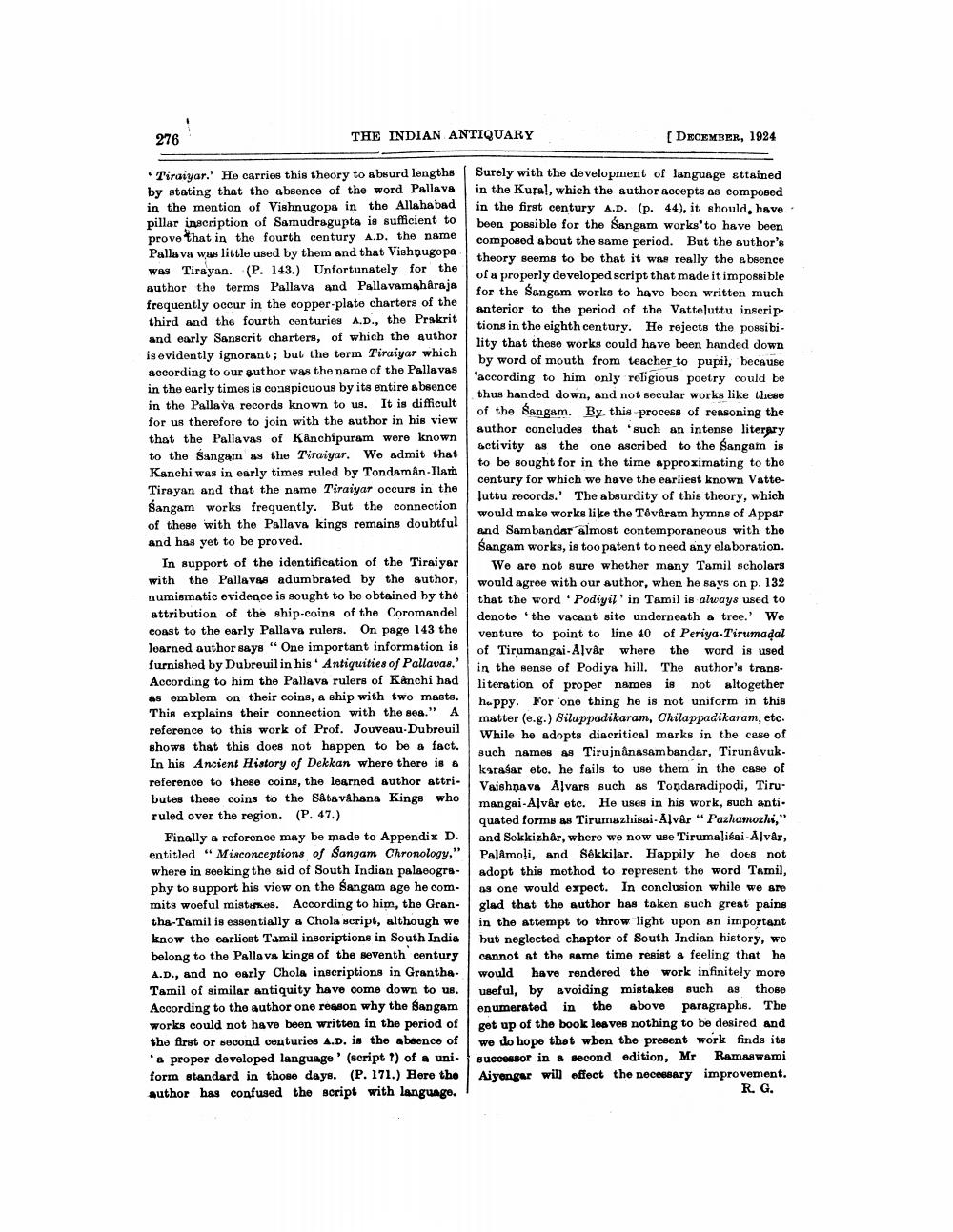________________
276
C
THE INDIAN ANTIQUARY
Tiraiyar.' He carries this theory to absurd lengths by stating that the absence of the word Pallava in the mention of Vishnugopa in the Allahabad pillar inscription of Samudragupta is sufficient to prove that in the fourth century A.D. the name Pallava was little used by them and that Vishnugopa was Tirayan. (P. 143.) Unfortunately for the author the terms Pallava and Pallavamaharaja frequently occur in the copper-plate charters of the third and the fourth centuries A.D., the Prakrit and early Sanscrit charters, of which the author is evidently ignorant; but the term Tiraiyar which according to our author was the name of the Pallavas in the early times is conspicuous by its entire absence in the Pallava records known to us. It is difficult for us therefore to join with the author in his view that the Pallavas of Kanchipuram were known to the Sangam as the Tiraiyar. We admit that Kanchi was in early times ruled by Tondamân-Ilam Tirayan and that the name Tiraiyar occurs in the Sangam works frequently. But the connection of these with the Pallava kings remains doubtful and has yet to be proved.
In support of the identification of the Tiraiyar with the Pallavas adumbrated by the author, numismatic evidence is sought to be obtained by the attribution of the ship-coins of the Coromandel coast to the early Pallava rulers. On page 143 the learned author says "One important information is furnished by Dubreuil in his Antiquities of Pallavas,' According to him the Pallava rulers of Kanchi had as emblem on their coins, a ship with two masts. This explains their connection with the sea." A reference to this work of Prof. Jouveau-Dubreuil shows that this does not happen to be a fact. In his Ancient History of Dekkan where there is a reference to these coins, the learned author attributes these coins to the Satavahana Kings who
ruled over the region. (P. 47.)
Finally a reference may be made to Appendix D. entitled "Misconceptions of Sangam Chronology," where in seeking the aid of South Indian palaeography to support his view on the Sangam age he commits woeful mistakes. According to him, the Grantha-Tamil is essentially a Chola script, although we know the earliest Tamil inscriptions in South India belong to the Pallava kings of the seventh century A.D., and no early Chola inscriptions in GranthaTamil of similar antiquity have come down to us. According to the author one reason why the Sangam works could not have been written in the period of the first or second centuries A.D. is the absence of 'a proper developed language' (script ?) of a uniform standard in those days. (P. 171.) Here the author has confused the script with language.
[DECEMBER, 1924
Surely with the development of language attained in the Kural, which the author accepts as composed in the first century A.D. (p. 44), it should, have been possible for the Sangam works to have been composed about the same period. But the author's theory seems to be that it was really the absence of a properly developed script that made it impossible for the Sangam works to have been written much anterior to the period of the Vatteluttu inscriptions in the eighth century. He rejects the possibility that these works could have been handed down by word of mouth from teacher to pupil, because according to him only religious poetry could be
thus handed down, and not secular works like these
of the Sangam. By this process of reasoning the author concludes that such an intense literary activity as the one ascribed to the Sangam is to be sought for in the time approximating to the century for which we have the earliest known Vatteluttu records. The absurdity of this theory, which would make works like the Têvåram hymns of Appar and Sambandar almost contemporaneous with the Sangam works, is too patent to need any elaboration.
We are not sure whether many Tamil scholars would agree with our author, when he says on p. 132 that the word Podiyil' in Tamil is always used to denote the vacant site underneath a tree.' We venture to point to line 40 of Periya-Tirumadal of Tirumangai-Alvår where the word is used in the sense of Podiya hill. The author's transliteration of proper names is not altogether happy. For one thing he is not uniform in this matter (e.g.) Silappadikaram, Chilappadikaram, etc. While he adopts diacritical marks in the case of such names as Tirujnânasambandar, Tirunâvuk. karasar etc. he fails to use them in the case of Vaishnava Alvars such as Tondaradipodi, Tirumangai-Alvår etc. He uses in his work, such anti. quated forms as Tirumazhisai-Alvar "Pazhamozhi," and Sekkizhar, where we now use Tirumalisai-Alvår, Palamoli, and Sékkilar. Happily he does not adopt this method to represent the word Tamil, as one would expect. In conclusion while we are glad that the author has taken such great pains in the attempt to throw light upon an important but neglected chapter of South Indian history, we cannot at the same time resist a feeling that he would have rendered the work infinitely more useful, by avoiding mistakes such as those enumerated in the above paragraphs. The get up of the book leaves nothing to be desired and we do hope that when the present work finds its successor in a second edition, Mr Ramaswami Aiyengar will effect the necessary improvement.
R. G.




